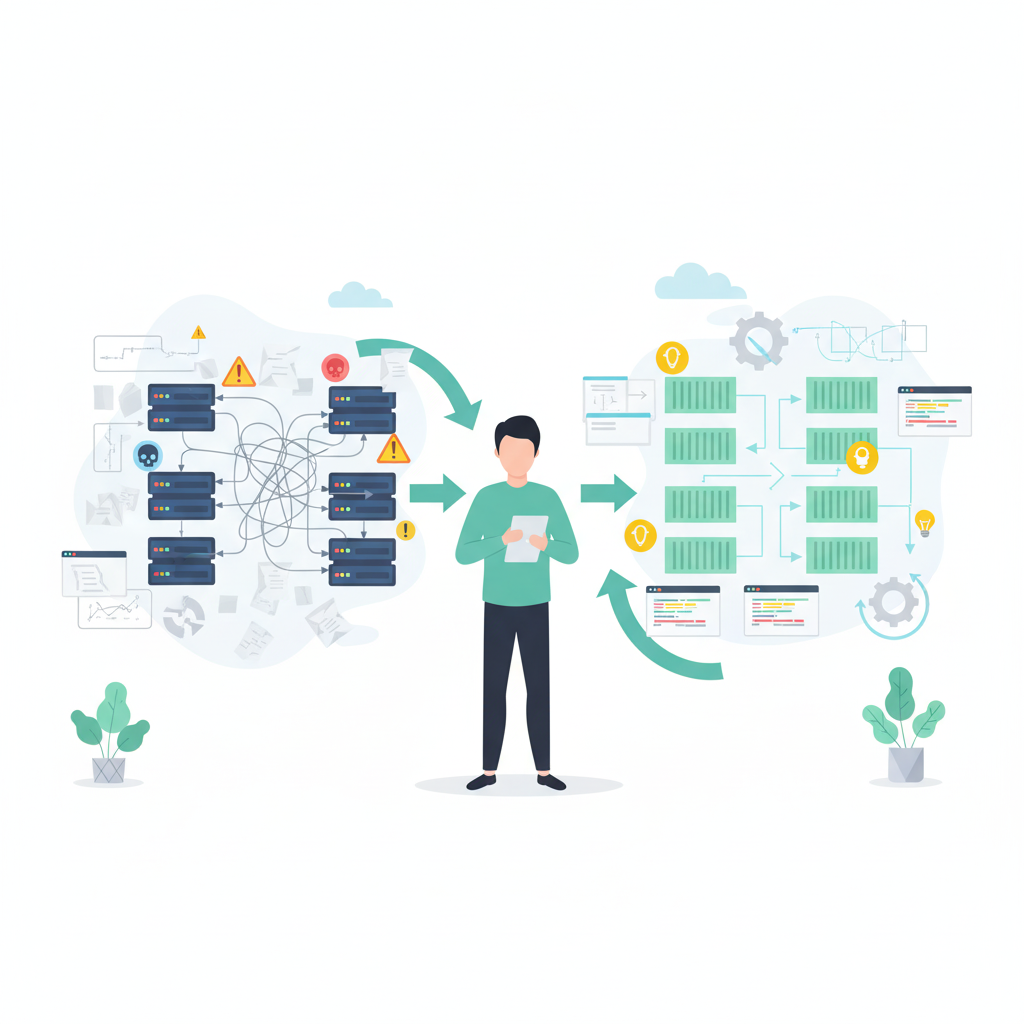Inheriting legacy systems with substantial technical debt presents one of the most challenging scenarios in technology leadership. The pressure to modernise can feel overwhelming, yet rushing into modernisation without a strategic framework often leads to project failures, budget overruns, and operational disruptions. This guide builds on the foundational understanding from our comprehensive technical debt assessment framework to address legacy-specific challenges.
This guide provides proven strategies for systematically modernising legacy systems while reducing technical debt. You’ll discover assessment frameworks to evaluate your current state, decision criteria for choosing between refactoring and rewriting, implementation approaches including the Strangler Fig pattern, and risk mitigation strategies. Whether you’re dealing with monolithic applications requiring microservices transformation or simply need to reduce maintenance overhead, these evidence-based approaches will help you build a successful modernisation roadmap that delivers measurable results.
How do I assess technical debt in inherited legacy systems?
Assessment begins with automated code analysis tools like SonarQube to measure cyclomatic complexity, code coverage, and maintainability metrics. Combine technical metrics with business impact analysis including maintenance costs, deployment frequency, and developer velocity to create a comprehensive Technical Debt baseline for prioritisation decisions.
SonarQube provides automated assessment capabilities that measure code complexity, detect duplications, and evaluate maintainability indices. This Assessment Framework should focus on both code quality and documentation completeness, as technical debt immediately affects both development efficiency and team productivity in measurable ways.
Three key metrics represent Technical Debt effectively: Complexity (effort required for new features), Risk (probability of system disruption), and Overall debt (additional work required beyond optimal implementation). Machine learning models can accurately assess technical debt levels in applications even without prior knowledge of the codebase structure.
Your Code Quality Assessment should detect inefficiencies using metrics like cyclomatic complexity and code duplication. A Technical Debt Ratio (TDR) of less than five per cent is ideal for demonstrating value to executives and maintaining development velocity.
Use a cost-impact matrix within your Assessment Framework to classify technical debt into high-impact/low-cost fixes, high-impact/high-cost challenges, and low-impact/high-cost items. This prioritisation approach ensures you address the most valuable improvements first while building momentum for larger modernisation initiatives.
When should I refactor vs rewrite legacy systems from scratch?
Refactor when systems have good business logic but poor code structure, limited technical debt scope, and functioning core algorithms. Rewrite when technical debt exceeds 60% of codebase, underlying architecture cannot support business requirements, or when modernisation costs exceed development of new systems.
Your Refactoring Strategy works best when systems have well-defined and maintained boundaries, while a Rewrite Strategy becomes necessary for systems with little to no visible seams. Both approaches are valid solutions under different circumstances, with incremental refactoring generally being safer.
Key decision factors in your Assessment Framework include evaluating performance bottlenecks, maintenance cost analysis, security and compliance requirements, and technology integration potential. Consider processes that depend on the system and assess whether they can tolerate the disruption of a complete rewrite.
Timebox a few refactoring tickets even when considering a rewrite to validate the approach and strengthen the business case. Code toxicity analysis tools such as CheckStyle can help make informed decisions around rewrite versus reuse.
Calculate ROI using the formula: (Cost Savings + Revenue Gains) / Investment Cost = ROI %. Factor in developer productivity improvements, reduced maintenance overhead, and enhanced system reliability when evaluating options.
How does the Strangler Fig pattern work for gradual system replacement?
The Strangler Fig pattern gradually replaces legacy components by building new functionality around existing systems, routing traffic through an API Gateway to direct requests to either legacy or modern components. New features go to modern services while legacy functions remain until safely migrated, reducing big-bang rewrite risks.
A façade (proxy) intercepts requests that go to the back-end legacy system and routes these requests either to the legacy application or to the new services. This Incremental Modernisation approach provides a powerful and low-risk way for gradually modernising legacy systems.
The Strangler Fig Pattern consists of three distinct steps: transform (create modernised components), coexist (keep monolith available for rollback), and eliminate (remove legacy components). During the transform phase, you build new functionality alongside the old system.
Implementation requires incorporating an API Gateway such as Amazon API Gateway at the perimeter of your monolith to redirect traffic to the modernised version. Route requests through middleware that can forward them to the legacy system or the new components, updating the middleware configuration as components become available.
Use API versioning, compatibility layers, feature toggles, and schema evolution to ensure backward compatibility during transition. Change Data Capture tools help maintain data synchronisation between old and new systems throughout the migration process. This allows continuous operation while gradually replacing components, minimising business impact.
Should I migrate to microservices or modernise my existing monolith?
Choose Microservices Architecture when you have team autonomy requirements, need independent scaling, and can support distributed system complexity. Modernise the Monolith Architecture when teams are small, system boundaries are unclear, or when operational complexity of distributed systems exceeds organisational capabilities and technical debt reduction goals.
Microservices support polyglot development allowing teams to choose the best technology stack for their specific service, while monoliths have a single technology stack that may limit flexibility but reduces complexity. Teams organised around business capabilities with each team owning a specific service benefit from Microservices Architecture.
Your Team Capability Assessment should evaluate operational maturity before choosing microservices. Each new microservice introduces costs for test suite, deployment playbooks, hosting infrastructure, and monitoring tools. Development sprawl in microservices adds complexity and can result in slower development speed if not properly managed.
For organisations with strong write consistency requirements, consider a purposefully designed modular monolith when consistency is more important than independent deployment and scaling. This approach provides some benefits of separation without the operational overhead of distributed systems.
Container Orchestration and CI/CD pipelines must be in place to streamline development, testing, and deployment processes before transitioning to microservices. When selecting technologies for Microservices Architecture, ensure they are well-supported and align with your team’s expertise and project requirements.
What are the main risks in legacy system modernisation projects?
Primary risks include business disruption during migration, data loss or corruption, performance degradation, and integration failures with dependent systems. Mitigation requires comprehensive Rollback Strategy development, parallel system operation, extensive testing environments, and phased deployment approaches with continuous Performance Monitoring.
Legacy systems lack modern security frameworks, making them vulnerable to cyberattacks, with over 60% of data breaches involving legacy systems with inadequate controls. Migration Risk categories include technical risks such as security vulnerabilities, performance bottlenecks, and integration failures, alongside operational risks including resource allocation issues and knowledge transfer barriers.
Statistics reveal that 74% of organisations fail to complete legacy system modernisation projects, with 56% attributing this to fear of change and lack of funding. Data synchronisation problems can occur if synchronisation between old and new systems fails at any point during the transition process.
Your Rollback Strategy must include comprehensive procedures for reverting changes in case issues arise during transition. Implement Performance Monitoring and logging for both old and new components to help detect and diagnose issues, performance bottlenecks, and ensure system health throughout the modernisation process. For systematic approaches to executing these changes, see our technical debt reduction implementation strategies guide.
Security Compliance requirements should include network segmentation, virtual patching, strict access control, encryption tunnels, and continuous monitoring as protection techniques during the modernisation process. These security measures help protect systems without requiring full replacement, providing interim protection while modernisation proceeds.
How do I build vs buy expertise for legacy modernisation?
Build internal capabilities when modernisation is core to long-term strategy, you have time for team development, and can attract skilled developers. Buy External Consultants when facing tight deadlines, lacking specific skills, or need proven methodologies. Consider hybrid approaches with knowledge transfer requirements for sustainable outcomes.
The key questions in your Team Capability Assessment are: Does this create strategic differentiation? Are we the best company to build this capability? Do we have the appropriate skills to build it better than available alternatives? If your business is not primarily building technology, External Consultants may be more cost-effective than developing internal capabilities.
For organisations where technology modernisation represents a core competency, building internal capabilities provides long-term strategic value and organisational learning. This approach works best when you have sufficient time for team development, access to skilled talent, and the modernisation effort aligns with business strategy.
External Consultants become valuable when facing compressed timelines, lacking domain-specific knowledge, or requiring proven methodologies that reduce project risk. Consultants bring experience from multiple modernisation projects and can accelerate delivery while transferring knowledge to internal teams.
Hybrid approaches combine External Consultants with internal capability development through structured knowledge transfer. This strategy provides immediate project progress while building sustainable internal capabilities for ongoing modernisation efforts.
How do I create an incremental modernisation roadmap?
Start with dependency mapping and business value prioritisation to identify modernisation candidates. Create phases based on risk tolerance and business impact, beginning with isolated components and progressing to core systems. Include rollback points, success metrics, and resource allocation plans for each phase.
Your Incremental Modernisation roadmap requires understanding current system architecture, identifying components with the highest Technical Debt, and evaluating business value delivered by each potential modernisation effort. Legacy system modernisation typically takes 6 months for simple refactoring to 2-3 years for complex rewrite projects.
Begin with low-risk, high-value components that are relatively isolated from core business processes. This approach allows teams to build experience with modernisation techniques while delivering early wins that demonstrate value to stakeholders.
Define clear success metrics for each phase including deployment frequency improvements, defect rate reductions, developer velocity increases, and maintenance cost decreases. These metrics provide objective validation of modernisation progress and support continued investment in the roadmap.
Resource allocation planning must account for both modernisation work and ongoing maintenance of legacy systems during transition periods. Teams typically require 20-30% additional capacity during modernisation to maintain existing systems while building new components.
What metrics indicate successful technical debt reduction?
Key metrics include deployment frequency increases, lead time reduction, defect rates decline, and developer velocity improvements. Monitor code quality scores, maintenance effort reduction, system availability improvements, and total cost of ownership changes to validate modernisation investment returns and ongoing Technical Debt management.
Technical metrics provide objective measurement of modernisation progress through your Performance Monitoring systems. Track cyclomatic complexity reduction, code coverage improvements, and Technical Debt ratio changes over time. These metrics demonstrate concrete improvements in Code Quality Assessment that support long-term system sustainability.
Business metrics translate technical improvements into organisational value. Monitor deployment frequency, lead time, recovery time, and change failure rate to demonstrate improved delivery capabilities through your CI/CD Pipeline. These metrics directly correlate with business agility and competitive advantage.
Developer productivity metrics include velocity improvements, reduced time spent on maintenance tasks, and increased feature development capacity. Survey developers regularly about their perception of system quality, development experience, and confidence in making changes.
System reliability metrics such as uptime improvements, reduced incident frequency, and faster recovery times demonstrate operational benefits of modernisation. Track total cost of ownership changes including reduced infrastructure costs, lower maintenance overhead, and improved operational efficiency.
FAQ Section
How long does legacy system modernisation typically take?
Modernisation timelines range from 6 months for simple refactoring to 2-3 years for complex rewrite projects, depending on system size, technical debt levels, and chosen approach.
What’s the average cost of legacy system modernisation?
Costs typically range from 50-200% of original system development costs, with Strangler Fig approaches generally requiring lower upfront investment than complete rewrites.
Can I modernise legacy systems without business disruption?
Yes, using incremental approaches like the Strangler Fig pattern allows continuous operation while gradually replacing components, minimising business impact.
What skills does my team need for successful modernisation?
Essential skills include cloud architecture, containerisation, API design, automated testing, and change management, plus domain knowledge of existing systems.
How do I handle data migration during modernisation?
Use Change Data Capture tools for real-time synchronisation, maintain data consistency checks, and implement comprehensive backup and rollback procedures.
Should I modernise everything at once or in phases?
Phased approaches reduce risk and allow learning from early implementations, while big-bang approaches may be suitable for smaller, less critical systems.
What are the warning signs that immediate modernisation is needed?
Critical indicators include deployment failures exceeding 20%, developer productivity declining over 6 months, and maintenance costs exceeding 70% of development budget.
How do I get executive buy-in for modernisation budgets?
Present business impact metrics including downtime costs, developer productivity losses, and competitive disadvantages alongside clear ROI projections and risk mitigation plans.
Can I use open source tools for legacy modernisation?
Yes, tools like Kubernetes for orchestration, Apache Kafka for event streaming, and various assessment frameworks provide cost-effective modernisation support.
What happens if modernisation projects fail?
Failure rates decrease with proper assessment, phased approaches, and rollback strategies. Learn from failures to adjust approach rather than abandoning modernisation goals.
How do I maintain security during legacy modernisation?
Implement security reviews at each phase, maintain compliance frameworks, use Infrastructure as Code for consistent security configurations, and monitor for vulnerabilities continuously.
Should I modernise on-premise or move to cloud?
Cloud platforms offer modernisation tools and scalability, but consider data sovereignty, existing infrastructure investments, and team cloud readiness in decision-making.
Conclusion
Legacy system modernisation succeeds when approached systematically with clear Assessment Frameworks, realistic planning, and appropriate risk management. The choice between refactoring and rewriting depends on Technical Debt levels, business requirements, and organisational capabilities rather than universal best practices.
Incremental approaches like the Strangler Fig Pattern provide safer paths to modernisation while maintaining business continuity. Whether choosing Microservices Architecture or modernising existing monoliths, align architectural decisions with Team Capability Assessment results and operational maturity.
Success requires balancing build versus buy decisions for expertise, creating realistic roadmaps with measurable milestones, and tracking meaningful metrics that demonstrate both technical improvements and business value. Start your modernisation journey by conducting a comprehensive Technical Debt assessment using our foundational technical debt identification guide, then develop a phased approach that builds capability while delivering incremental value to your organisation.












